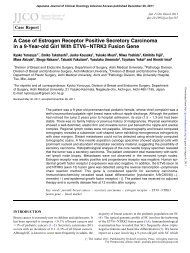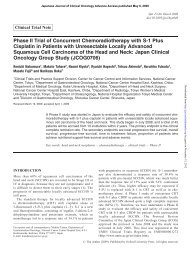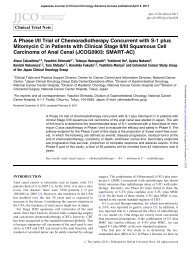Multi-Bracket Appliance in Management of Mandibular ...
Multi-Bracket Appliance in Management of Mandibular ...
Multi-Bracket Appliance in Management of Mandibular ...
You also want an ePaper? Increase the reach of your titles
YUMPU automatically turns print PDFs into web optimized ePapers that Google loves.
124 <strong>Multi</strong>-bracket appliance <strong>in</strong> management <strong>of</strong>mandibular reconstruction<br />
Figure 3. (d) Postoperative frontal view one year after surgery. (e) Postoperative<br />
panoramic radiograph one year after surgery.<br />
arch-wires were applied to the proposed residual teeth (Fig. 4c).<br />
Segmental mandibulectomy from above the left angle to the left<br />
can<strong>in</strong>e was performed. Bone defect was reconstructed with a<br />
fibula flap from the left lowerleg. There wereno sk<strong>in</strong> defectsand<br />
a small mucosal defect was directly sutured. One year after the<br />
operation, he was very satisfied with his facial appearance. He<br />
alsodemonstratedstableand goodocclusion. (Figs4d,4e and4f).<br />
DISCUSSION<br />
Despite the smallsamplesize,the presentresults from mandibular<br />
reconstruction us<strong>in</strong>g a multi-bracket appliance are very<br />
encourag<strong>in</strong>g. This technique <strong>of</strong>fers two major advantages over<br />
the conventional dental arch-bar.<br />
First, themulti-bracket appliance keepstheorig<strong>in</strong>aldentalarch<br />
form firmly. <strong>Bracket</strong>s are bonded to the <strong>in</strong>dividual teeth directly<br />
without any loosen<strong>in</strong>g. Rectangular arch-wires control the<br />
<strong>in</strong>dividualtoothpositionthree-dimensionally and have considerable<br />
stiffness to counter the external pressure. These properties<br />
are helpful <strong>in</strong> ma<strong>in</strong>ta<strong>in</strong><strong>in</strong>g occlusion <strong>of</strong> the rema<strong>in</strong>ig dentition<br />
accurately<strong>in</strong> bonegraft<strong>in</strong>gprocedureas wellas protect<strong>in</strong>gaga<strong>in</strong>st<br />
postsurgical wound contraction. On the other hand, the dental<br />
arch-bar is attached to teeth by ligature wires and <strong>of</strong>ten loosens<br />
<strong>in</strong> maxillo-mandibular fixation . Furthermore, this appliancedoes<br />
not demonstrate sufficient mechanical strength. In contrast, the<br />
dental arch-bar, when used for mandibular fracture, enables<br />
accuratefixation <strong>of</strong> the mandible. This is due to the lack <strong>of</strong> bony<br />
ands<strong>of</strong>t tissuedefects. Thus,thearchedshape <strong>of</strong>the mandiblecan<br />
be perfectlyrestoredwhichpreservesthe rigid maxilla-mandibular<br />
fixation. Baurmash reports that there is little difference<strong>in</strong> the<br />
strength<strong>of</strong> attachment if one is deal<strong>in</strong>gwitha fulldentalarch, but<br />
the difference<strong>in</strong> strength is evidentwhen only a small number<strong>of</strong><br />
anchor<strong>in</strong>gsare available (4).<br />
In the case <strong>of</strong> mandibular resection follow<strong>in</strong>g tumor ablation,<br />
the tissue defect is generally large and the number <strong>of</strong> rema<strong>in</strong><strong>in</strong>g<br />
teeth is small. Initially horseshoe-shaped mandibles are divided<br />
<strong>in</strong>to two relatively straightsticks. A small number<strong>of</strong> circumdental<br />
wires is considered to be <strong>in</strong>sufficient to hold the arch-bars<br />
rigidly whichresults <strong>in</strong>considerable movement<strong>of</strong> the mandibles,<br />
even under maxillo-mandibular fixation. Therefore, hold<strong>in</strong>g the<br />
mandibles<strong>in</strong> positionpreciselydur<strong>in</strong>gbonegraft<strong>in</strong>gprocedureis<br />
difficult. Furthermore, as the teethelongatedur<strong>in</strong>g maxilla-mandibular<br />
fixation, circumdental wires tend to loosen a few weeks<br />
after surgery and the support<strong>in</strong>g teeth move toward the reconstructed<br />
direction. Re-tighten<strong>in</strong>g <strong>of</strong> the wires is <strong>of</strong>ten required<br />
which sometimes leads to periodontal <strong>in</strong>jury (5). We have<br />
occasionally experienced deterioration <strong>of</strong> occlusion after the<br />
removal <strong>of</strong> the arch-bars due to woundcontractionand resultant<br />
boneremodel<strong>in</strong>gwhichcont<strong>in</strong>uefor several monthsaftersurgery.<br />
The multi-bracketapplianceappearsto solvethese problems, but<br />
the contribution<strong>of</strong> the acrylicplate should also be considered.<br />
The multi-bracket appliance also keeps the oral cavity clean.<br />
This appliance is designed for long-term use <strong>in</strong> orthodontic<br />
treatmentwhileavoid<strong>in</strong>gperiodontal <strong>in</strong>jury. Thus, long-term use<br />
<strong>of</strong> this appliance ma<strong>in</strong>ta<strong>in</strong>s the occlusal relationship aga<strong>in</strong>st<br />
wound contraction. In contrast, arch-bars occasionally cause<br />
g<strong>in</strong>gival <strong>in</strong>fection around the circumdental wires and early<br />
removal <strong>of</strong> theseappliances is unavoidable. The wound contracture<br />
progresses after removal and deviation <strong>of</strong> the rema<strong>in</strong><strong>in</strong>g<br />
mandible occurs, result<strong>in</strong>g <strong>in</strong> destruction <strong>of</strong> occlusion. In the<br />
present series, multi-brackets were appliedfor 3 months without<br />
any complications.<br />
The goals <strong>of</strong> mandibularreconstruction are the restoration <strong>of</strong><br />
aestheticcontourandoral function <strong>in</strong>clud<strong>in</strong>gmastication, speech,<br />
Downloaded from<br />
http://jjco.oxfordjournals.org/<br />
by guest on March 2, 2013







